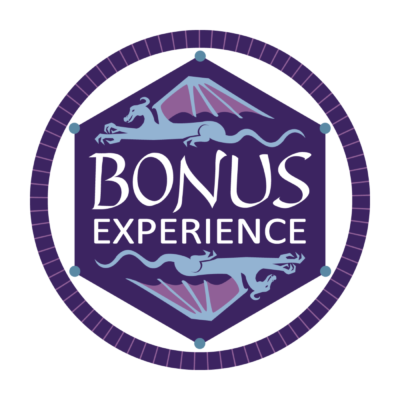Podcast: Play in new window | Download
Hello Bonus Babies,
Rai was ill during our usual recording time, so we brought in a friend to help! In today’s episode, Monica is joined by David Castro of Ink Stained Studios to talk D&D 4e: the good parts, the bad parts, its history, and its impact on current design. We’re very pro-4e, in case you’re wondering where we come down on the subject. If you’re looking for hate, this one ain’t it.
Also discussed in the extended cut: Hot tips for using trash as play aids, the true origins of “video game” powers, opinions about high-math rules and the nature of Monica’s dice magic.
Extra links: Bonus Experience 5: Games and the Art of Railroading. David’s Twitter, Website, DTRPG, and Patreon.
[ Bonus Experience: the Blog! bxpcast.com | Bonus Experience: the Discord! tinyurl.com/bxpdiscord | Bonus Experience: the Twitter! @bonusexpcast | Bonus Experience: the Patreon! patreon.com/bonusexperience ]

Thanks for talking 4th Edition.
There’s an obvious come-back to the “all the characters play exactly the same” and that is “In your edition [because this is true of every other edition] different spellcasters literally use the exact same spell as each other.” At least in 4th Edition, the wizard, sorcerer and bard aren’t all casting the exact same magic missile, and the cleric, shaman, and druid aren’t all casting the same cure light wounds spell.
It was sad about the online tools, but we had to see that that was coming, sooner or later. I was careful about not relying on any options I didn’t have the books or articles for, and I made sure I felt okay making characters by hand. It’s somewhat tricky, but at least it’s easy with Essentials characters (which I didn’t have a problem with). Anyway, my one consolation is that 5th Edition will probably get a shock to its system someday too.
I get that the roles tend to be very similar, but of course that’s really just skin deep. Each defender (role)plays very differently, as does each striker, controller and leader.
I don’t use maps or minis anymore, and it’s not that difficult (and I’m lazy too). Squares are 5 feet across: done. It’s not an identical experience, but it works fine.
The comeback I use about 4th Edition not supporting “roleplaying” (I will forever respect 5th Edition for calling it “interaction”), is that 4th Edtion was the only edition to even attempt (successfully, I think) to figure out how to make non-combat scenes worth runnning, and to integrate them into the rest of the game.
Also, Page 42 and actually putting “Say, ‘Yes, and…'” into print in a DM book. If the whole book was blank except for Page 42, it would still be the best DMG ever.
Critical Hit is rad. I’m only disappointed that I didn’t get into it until the end. I didn’t like their skill challenge rules though. Too contrived. The restriction on skills just drove extremely goofy skill usage. If you’re chasing something, you’re going to be running – it’s Athletics or Endurance. If the DM doesn’t want repeated rolls from the most obvious, relevant skills, they can add interesting complications.
Too many HP? Have your monsters burn theirs by provoking opportunity attacks to get to the weakest character and smash them.
Anyway, I still play 4th Edition, mostly online because the trade-offs are worth it. I play 5th Edition, just for the human contact, but I refuse to buy any books for it. It’s somewhat better than I thought (the group has a lot to do with the experience, I realize) but it’s also so much worse. I’ve played D&D since the late 80s, starting with the Mentzer Red Box, for what that’s worth. 4th Edition remains my favorite edition. It’s what I always wanted D&D to be. I wanted to be the person on the Red Box, going toe-to-toe with a dragon, using a shield that would actually help me against dragon breath, and 4th Edition gave me that.
Thanks again!